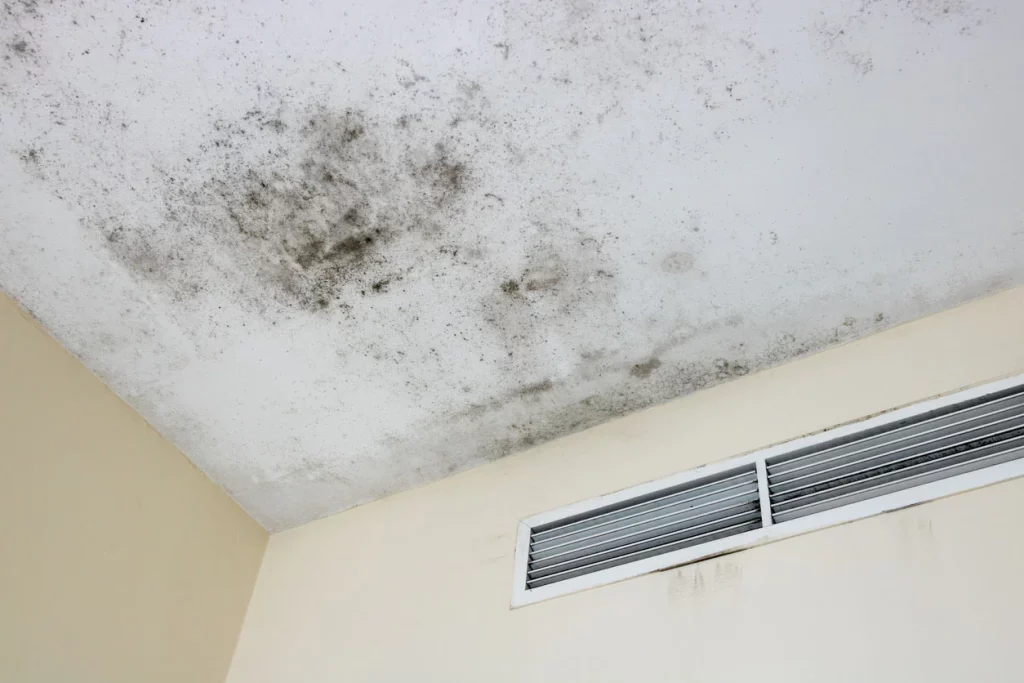Mold on the ceiling can be a common and frustrating issue for many homeowners. It’s not only unsightly but can also be a health hazard if left unaddressed. In this article, we will explore the reasons behind the presence of mold on your ceiling, the potential health risks associated with it, and most importantly, how to get rid of it. Let’s dive into the world of ceiling mold and find out what causes it and how to prevent it.

Understanding Mold: The Silent Intruder
Mold, a type of fungi, thrives in moist and humid environments. It’s not always easy to spot, as it often grows in hidden or less frequently visited areas of the home. Ceiling mold, in particular, can be perplexing. You might be wondering, “Why is there mold on my ceiling?” To understand the root of the issue, it’s essential to explore the potential causes.
Common Causes of Mold on the Ceiling
- Leaking Roof: One of the most common reasons for mold growth on your ceiling is a leaking roof. Even a small leak can lead to water seeping into the ceiling, creating the perfect environment for mold to thrive.
- Poor Ventilation: Inadequate ventilation can trap moisture in your home, leading to condensation and elevated humidity levels. When warm, moist air comes into contact with a cooler surface like your ceiling, it can result in mold growth.
- Plumbing Issues: Leaking pipes or plumbing problems in the floors or walls above can also cause water damage to the ceiling, providing mold with the necessary conditions to grow.
- Excessive Humidity: High humidity levels, especially in areas like bathrooms or kitchens, can contribute to mold growth. The steam and moisture produced during activities like cooking and showering can accumulate on the ceiling.
- Improper Insulation: Inadequate insulation in the ceiling can cause temperature differences between the indoor and outdoor air, leading to condensation and mold formation.
- Previous Water Damage: If your ceiling has experienced water damage in the past and wasn’t properly remediated, mold can continue to grow even after the surface appears to be dry.
The Health Risks of Ceiling Mold
Mold on the ceiling isn’t just a cosmetic issue; it can have adverse effects on your health. Mold spores, when released into the air, can be inhaled, leading to various health problems, including:
- Respiratory Issues: Mold spores can trigger or exacerbate respiratory problems like asthma and allergies.
- Skin Irritations: Contact with mold can cause skin rashes, itchiness, and irritation.
- Sinus Infections: Inhaling mold spores can lead to sinus infections, congestion, and other sinus-related problems.
- Eye Irritation: Mold exposure can cause eye redness, itchiness, and irritation.
- Headaches and Fatigue: Prolonged exposure to mold can lead to persistent headaches and a general feeling of fatigue.
Getting Rid of Mold on Your Ceiling
Now that we’ve explored the causes and potential health risks of ceiling mold, it’s crucial to understand how to address the issue effectively.
- Identify and Address the Source: The first step is to identify and fix the source of moisture or water that’s allowing mold to grow. This may involve repairing a leaking roof, resolving plumbing issues, or improving ventilation.
- Protective Measures: Before attempting any cleanup, make sure to take necessary precautions. Wear protective gear, including gloves, a mask, and eye protection, to minimize exposure to mold spores.
- Clean the Area: Remove the mold by scrubbing the affected area with a mixture of water and detergent. For stubborn mold, a mixture of water and vinegar can be effective. Be sure to thoroughly dry the area after cleaning.
- Painting with Mold-Resistant Paint: Consider repainting your ceiling with a mold-resistant paint to prevent future growth.
- Ventilation Improvement: Enhance ventilation in the affected area by installing exhaust fans or improving air circulation. Use a dehumidifier to control indoor humidity levels.
Read too: Drywall Early Stage Signs Of Termites In Ceiling
Conclusion
The sight of mold on your ceiling can be alarming, but understanding the causes and taking appropriate action can help you address the issue effectively. It’s not just about aesthetics; it’s also about your health and the well-being of your home. Remember that prevention is key when dealing with this damage. Regular maintenance, prompt repairs, and proper ventilation can go a long way in keeping your home mold-free. So, if you’ve ever asked yourself, “Why do I have mold on my ceiling?” you now have the knowledge and tools to tackle the problem head-on, ensuring a healthier and mold-free living space for you and your family.